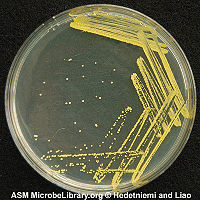Micrococcus luteus
| Micrococcus Luteus | ||||||||||||
|---|---|---|---|---|---|---|---|---|---|---|---|---|
 | ||||||||||||
| Scientific classification | ||||||||||||
| ||||||||||||
| Binomial name | ||||||||||||
| Micrococcus Luteus |
Micrococcus luteus, most commonly known as M. luteus, is a gram-positive bacteria that is most commonly found in mucous membranes such as the nasal cavities, the lining of the mouth etc. If we were to break down the word Micrococcus, it would be as follows: Micro, meaning microbe and coccus which stands for the organism's spherical shape. The second portion of the virus' name: luteus, stands for " yellow".The bacteria is also found in dust, soil the air that we breathe and is part of the human skin flora. [1] The bacteria is an obligate aerobe which can also live in very low concentrations of carbon.
Although it had been believed non-pathogenic, it is now considered an opportunistic pathogen, especially in immunocompromised patients. It is also responsible for nosocomial infections. Since it is a commensal on the skin and nasal cavities, it is often overlooked as a source of clinical infection.
Genome structure
Cell structure and metabolism
Micrococcus luteus grows yellow round-shaped colonies. Its cell wall is made of peptidoglycans linked together by amino-acids which would explain its ability to absorb the dark-blue or violet stains. It is known to cause odors in humans because of its ability to break down sweat components.[2]
Ecology
M.luteus can be found mostly in environments where the temperature is around 37oC since this is the temperature at which its usual milieu is known to be (skin/nasal cavity). The bacteria grows also in beer and its lifetime is limited in soil. M.luteus is specially known for its growth in dairy products which facilitates its transmission to its host after consumption of milk for instance. This organism is able to grow on inorganic nitrogen and cannot synthesize acid from glucose in the presence of oxygen. [3] M.Luteus can be used in the degradation of metals such as zinc, leand and nickel [4]
Pathology
As stated before, Micrococcus is not considered as a pathogen but rather as a bacteria that jumps on the first opportunity to enhance some infections in its host. When an individual is immuno-compromised, M.luteus tends to improve (boost)certain diseases like : meningitis, pneumonia, urinary tract infections. [5] This explains why hospitalized patients are the most susceptible to M.luteus' opportunistic's side of its pathology. Hence, new-borns and patients suffering from AIDS are more under the risk of infections caused by the bacteria. M.Luteus can cause severe itching and/or inflammation of the skin. These symptoms are found most of the time in patiens who have been admitted to the hospital. The bacteria is transmitted by the intermediary of the medical staff who may have failed to wash their hands properly by going from one patient to another. The symptoms could start appearing after 48 hours within the facilities.
Application to Biotechnology
M. Luteus has been used to make some studies on microbes’ susceptibility to lactoferrin (Lf), a glycoprotein. Lactoferrin is known to exert antibacterial activities by binding to the [lipomannan] of the cell wall of the microbe. The protein (mostly found in mammalian [exocrine] secretion) leads to the destruction of its host in certain species. For instance, in the Micrococcus genus, the glycoprotein is only effective in the M. luteus species but not for [M. radiophilus], [M.roseus] or [M.varians]. [6] However, lactoferrin is known for its iron-binding capacities. Since iron is one of the factors promoting microbial viability and growth, its binding to Lf stops the bactericidal effect. The studies show that the amount of iron present for the lactoferrin to bind, plays an important role in such activity. It is showed that the ferric salts were able to stop the antibacterial effect more than the ferrous salts could.
Because M.Luteus is part of the natural flora of the skin and mucous membranes, when a patient is under the influence of infections, the bacteria is not among the first pathogens that come to mind. Some tests have to be run in order to confirm that M.Luteus is indeed the one causing the symptoms. Often, M. Luteus can be mistaken for Straphylococcus aureus., a bacteria that, just like his homologue, can cause nocosomial infections. However, Some research has proven M. Luteus to be coagulase negative where as S. aureus is coagulase positive and is a facultative anaerobe. S.aureus is also known to be resistant to antibiotics, particularly bacitracin.
The Bacitracin succeptibility test is administered on M.luteus and S.aureus to differentiate one from another. A blood agar plate is prepared and separated in two sections. One side is where the M.Luteus will be deposited by the use of a sterile swab and the other side is where the S. aureus will be deposited. A small disk of bacitracin is then placed on each side of the blood agar plate and left to rest for a few hours. When the plate is then studied, one can notice that the area around the bacitracin disk placed in the M.luteus side of the blood agar plate is cleared out due to its antibacterial effect on the gram-positive bacteria. This area is known as the " zone of inhibition" thus it is succeptible to bacitracin. However, the contrary is observed for the S.aureus side of the plate since such bacteria is known to be antibacterial resistant. Bacitracin finds a certain difficulty to translate gram-negative bacteria's mRNA.
Current Research
References
- ↑ http://en.wikipedia.org/wiki/Micrococcus_luteus
- ↑ http://microbewiki.kenyon.edu/index.php/Micrococcus
- ↑ http://www.microbionet.com.au/mluteus.htm
- ↑ http://genome.jgi-psf.org/draft_microbes/miclu/miclu.home.html
- ↑ http://www.microbionet.com.au/mluteus.htm
- ↑ http://www3.interscience.wiley.com/cgi-bin/fulltext/119173366/main.html,ftx_abs